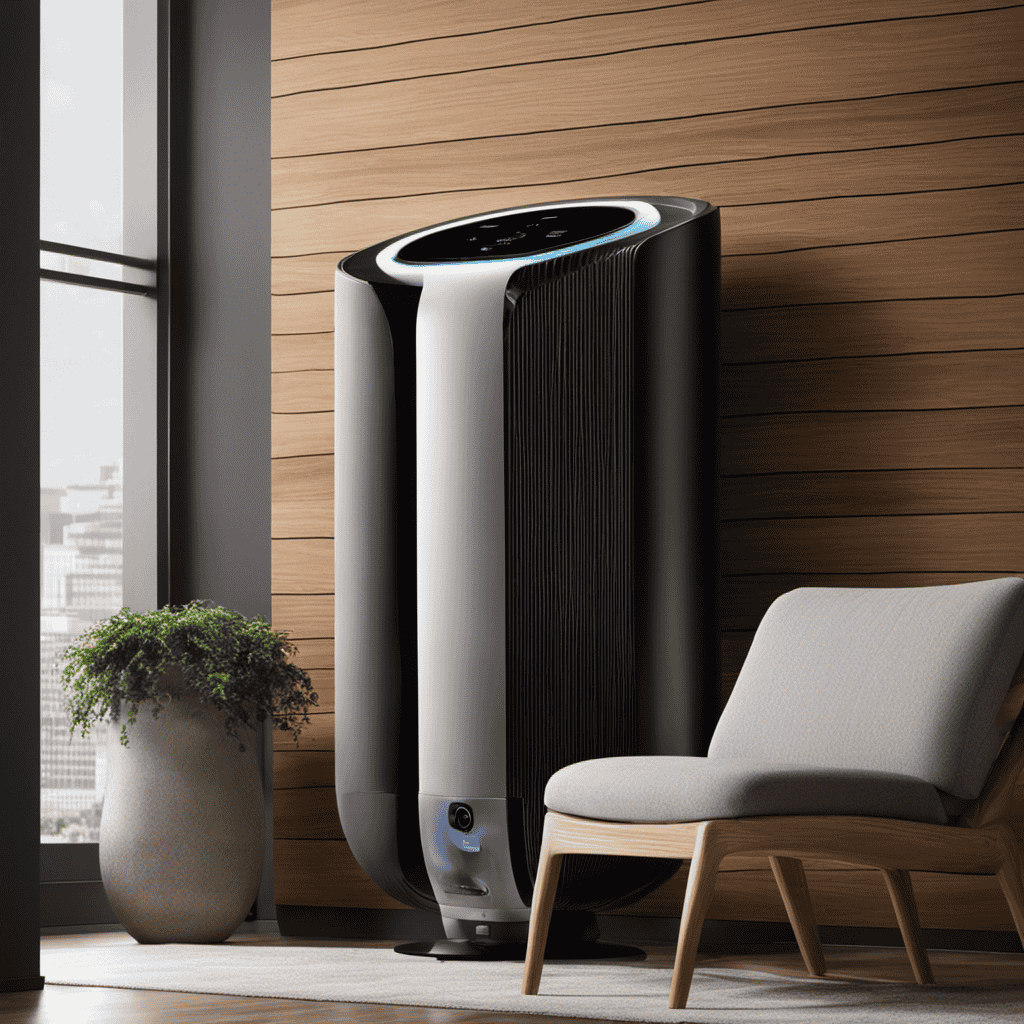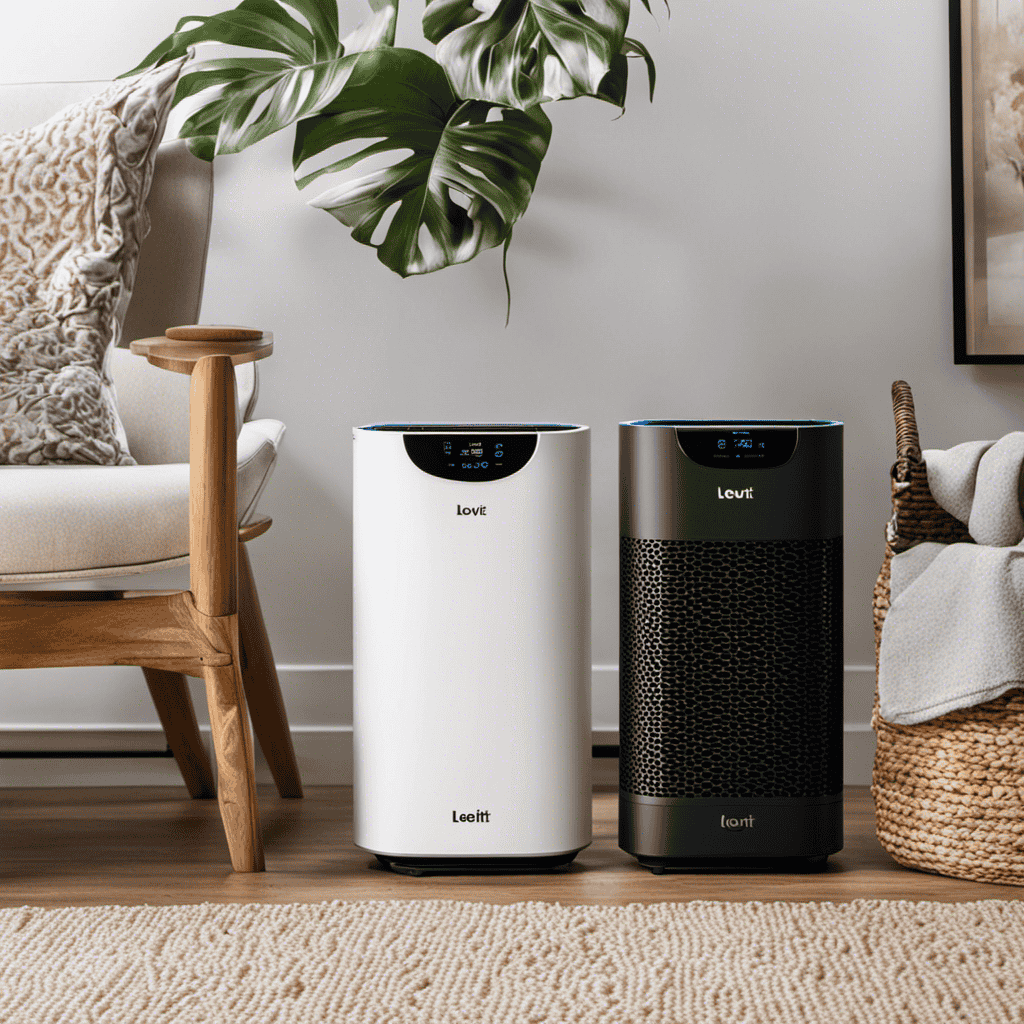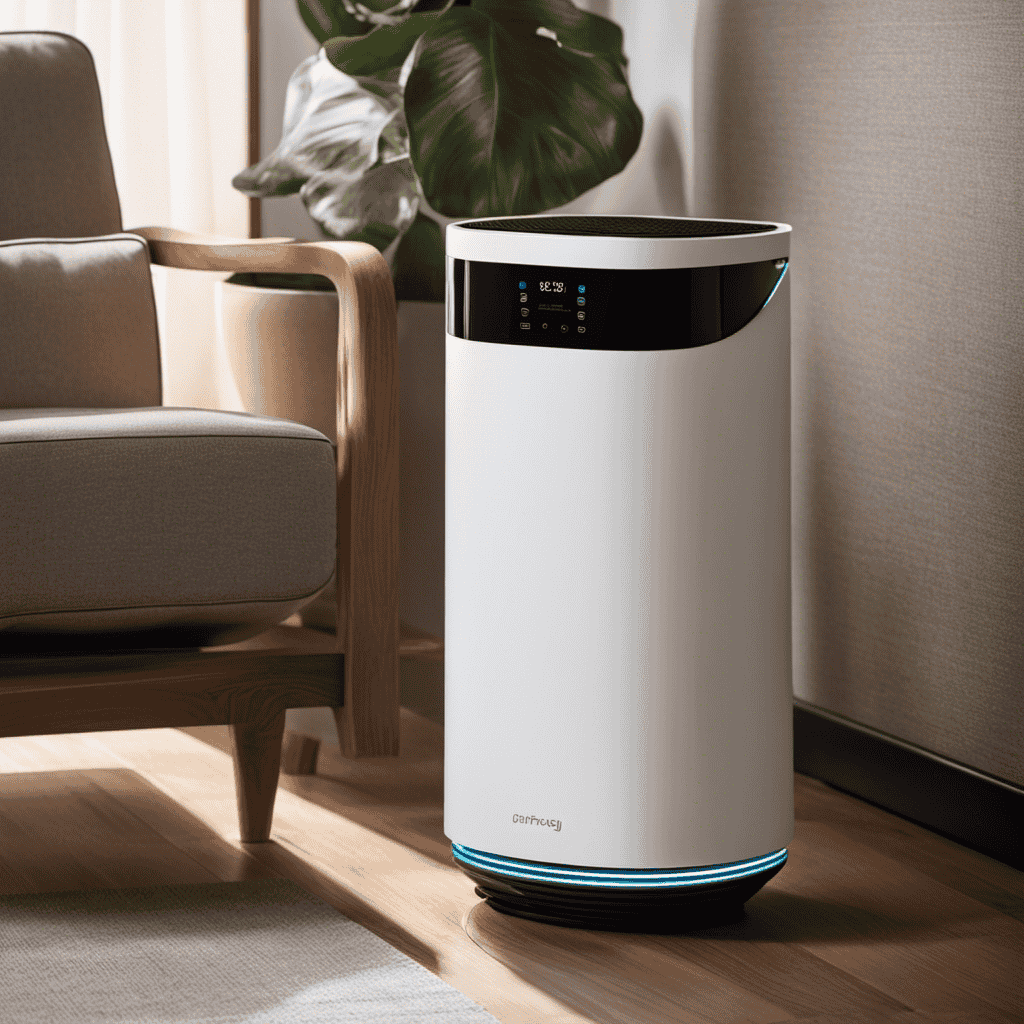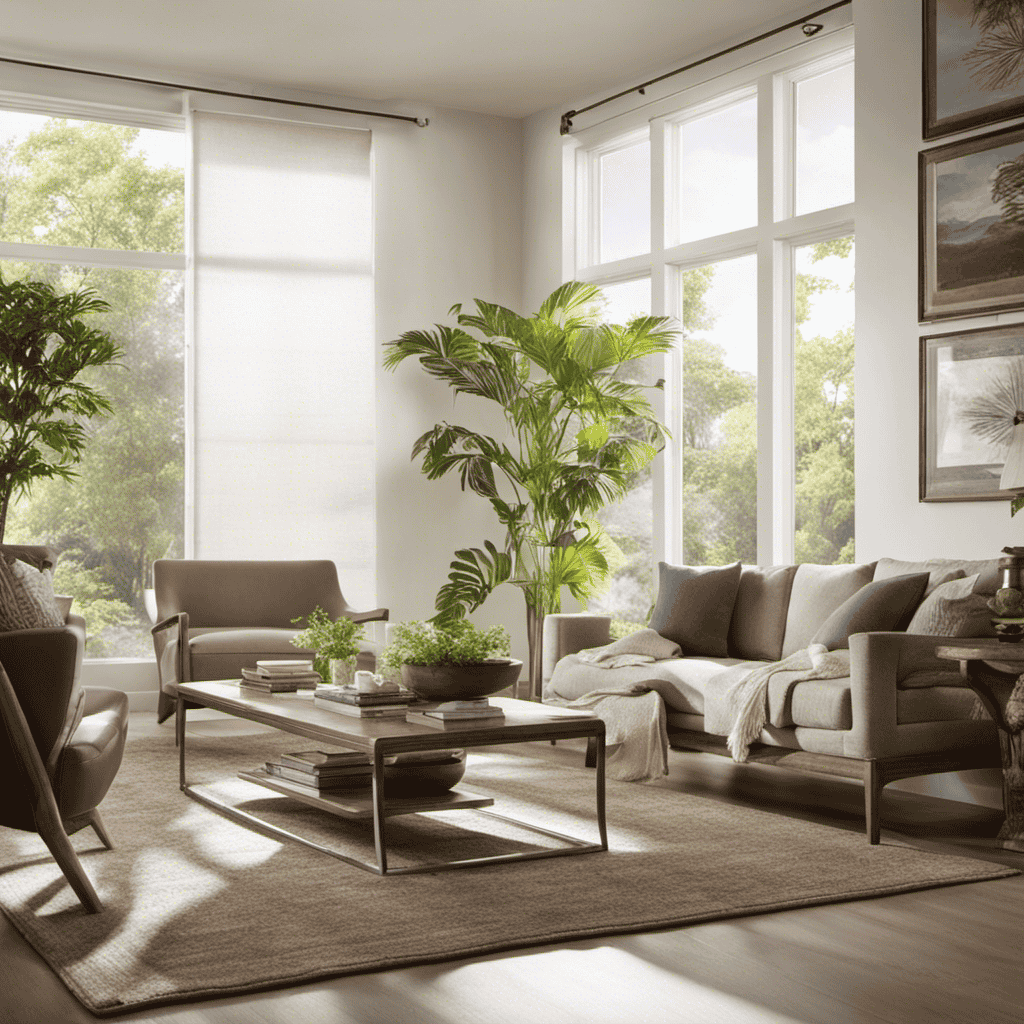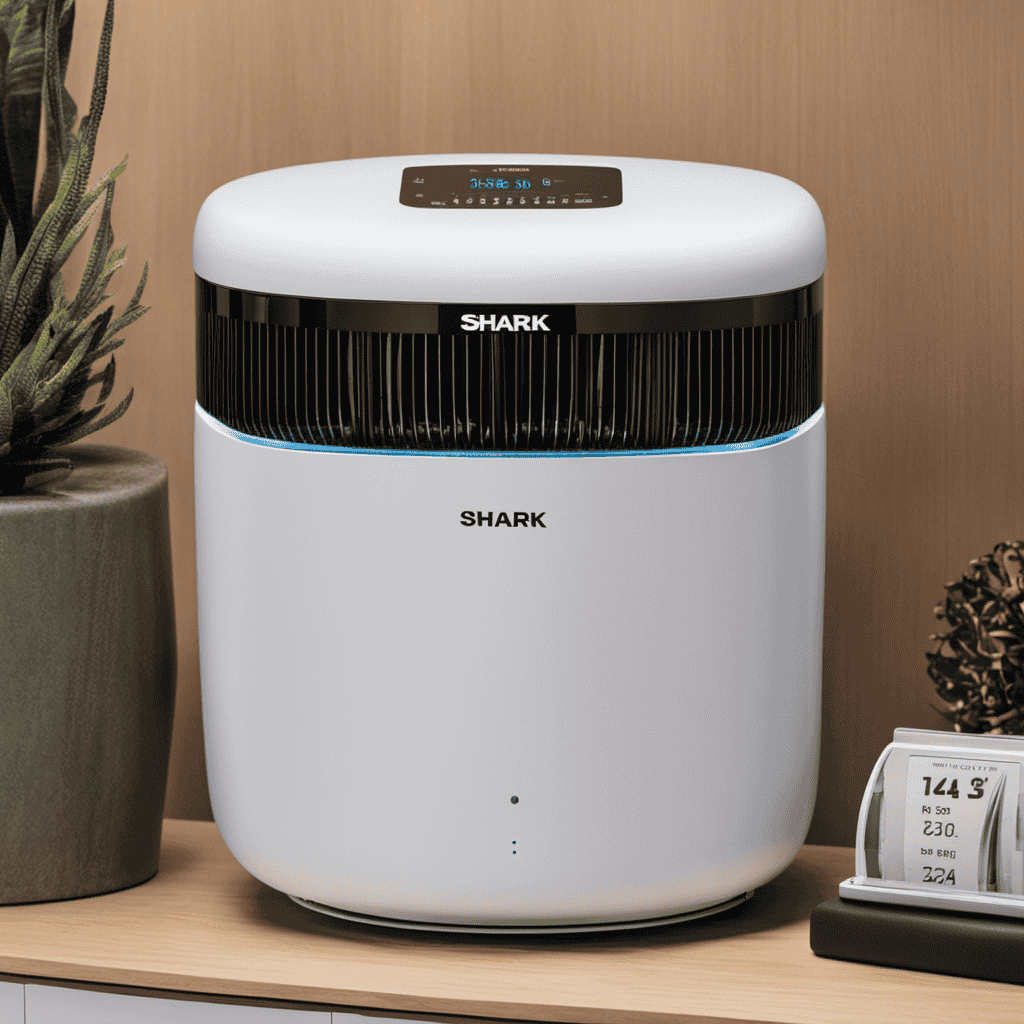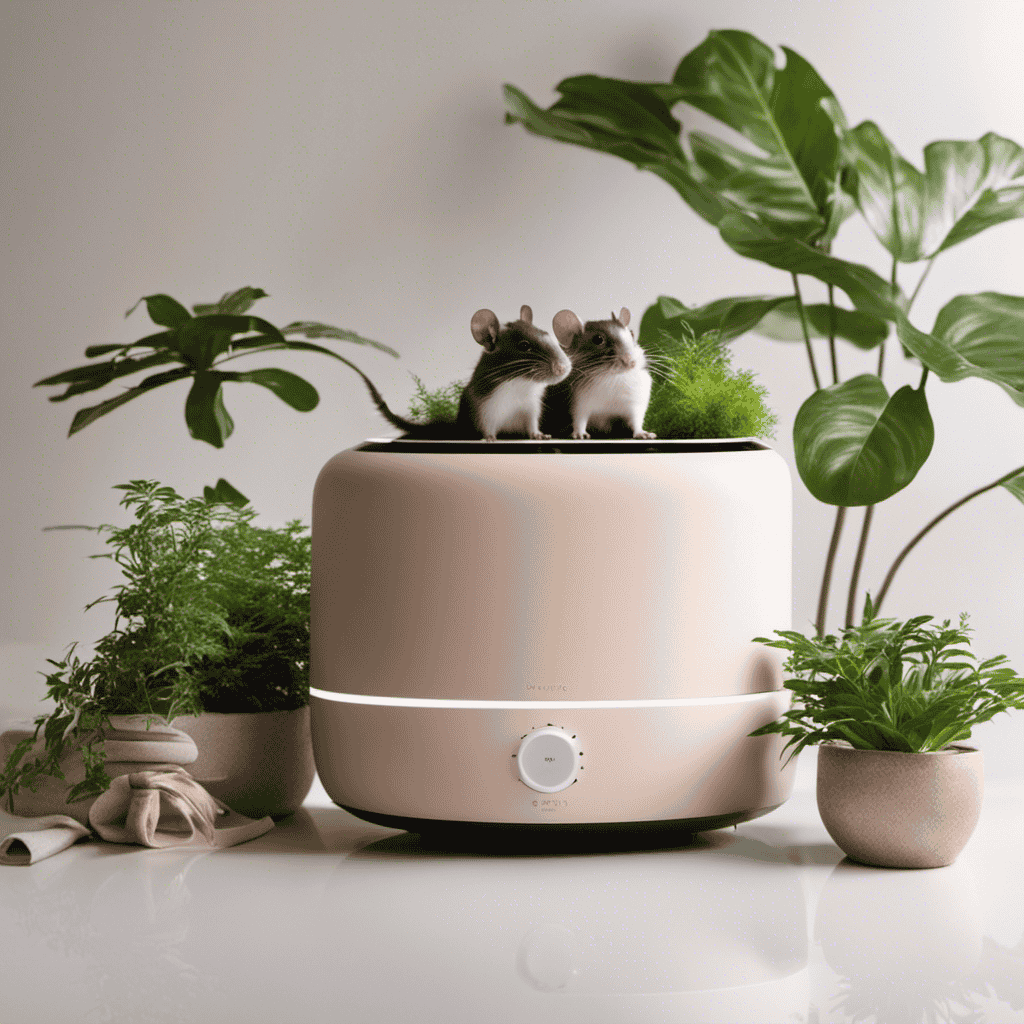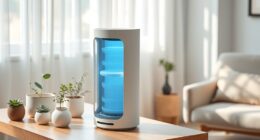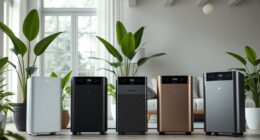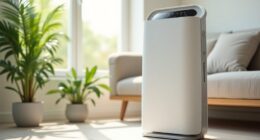While sitting in my living room, I can’t help but observe the dust particles swirling in the air. It’s a continuous struggle to maintain clean and fresh air.
That’s why I’ve invested in an air purifier. But now I find myself faced with a new dilemma – which way should it face?
In this article, we will explore the importance of proper air purifier placement and the optimal airflow patterns for maximum efficiency.
Let’s dive in and uncover the secrets to cleaner, healthier air in our homes.
Key Takeaways
- Proper placement of an air purifier is crucial for effective purification.
- Placing the air purifier near pollutant sources and windows can improve air quality.
- The direction of airflow should be facing towards the center of the room for better circulation and cleaner air.
- Avoid obstructing airflow by placing the air purifier behind furniture or in tight corners.
The Importance of Proper Air Purifier Placement
Proper air purifier placement is crucial in ensuring effective purification. The efficiency of an air purifier can be influenced by various factors, such as the size of the room, the layout of the furniture, and the location of potential pollutant sources. It is important to consider these factors when deciding where to place the air purifier.
Additionally, the impact of air quality on health further emphasizes the need for proper placement. Poor indoor air quality can lead to respiratory issues, allergies, and other health problems. By strategically placing the air purifier in areas where pollutants are most likely to accumulate, such as near windows or in the center of the room, it can effectively remove harmful particles and improve the overall air quality, promoting better health and well-being.
Factors to Consider When Positioning an Air Purifier
When positioning an air purifier, make sure you consider factors such as the size of the room and the proximity to potential sources of air pollution. Maximizing the efficiency of an air purifier can have a significant impact on the quality of the air in your home or office. To achieve this, it is essential to understand how the room layout can affect the performance of the air purifier.
One factor to consider is the placement of the air purifier in relation to potential sources of pollution. For example, if there is a window near a busy street, placing the air purifier near the window can help filter out pollutants from outside air before they enter the room. Additionally, considering the size of the room is crucial. A larger room may require a more powerful air purifier or multiple units strategically placed to cover the entire space effectively.
To further illustrate the impact of room layout on air purifier performance, consider the following table:
| Room Layout | Air Purifier Placement |
|---|---|
| Open Concept | Near the center of the room to ensure maximum coverage |
| Small Room | Near the main source of pollution, such as a smoking area |
| Large Room | Multiple air purifiers placed strategically to cover the entire space |
Optimal Airflow Patterns for Air Purifiers
Consider positioning your air purifier in a location that allows for optimal airflow patterns and maximum effectiveness in improving air quality. When it comes to maximizing efficiency, the direction in which your air purifier faces plays a crucial role. Research suggests that placing the air purifier in a way that allows air to flow freely throughout the room is essential.
To achieve this, it is recommended to position the air purifier near a wall or corner, facing towards the center of the room. This helps to create a circular airflow pattern, allowing the purifier to capture and filter airborne pollutants more effectively. By adjusting the direction in this manner, you can ensure that the air purifier works at its best to provide clean and fresh air.
Now let’s explore common mistakes to avoid when placing an air purifier.
Common Mistakes to Avoid When Placing an Air Purifier
When it comes to optimizing the effectiveness of an air purifier, proper placement is crucial.
In order to achieve optimal air circulation, it is important to avoid placing the unit in areas where airflow can be obstructed, such as behind furniture or in tight corners.
Additionally, considering the direction of the airflow is essential for ensuring that the air purifier efficiently captures and filters pollutants.
Optimal Placement Tips
For optimal placement, it’s important to position the air purifier in a central location within the room. This ensures that the air purifier can effectively circulate and clean the air in all areas of the room.
When considering the size of the room, it is crucial to choose an air purifier that is appropriate for the space. Larger rooms may require a more powerful air purifier or multiple units to maximize effectiveness. Similarly, smaller rooms may only need a compact air purifier. By considering the room size, you can ensure that the air purifier is capable of effectively cleaning the air in the given space.
With proper placement and appropriate sizing, the air purifier can efficiently remove pollutants and allergens from the room, creating a healthier environment.
Now, let’s explore how to avoid airflow obstruction for further optimization.
Avoiding Airflow Obstruction
When it comes to maximizing the efficiency of an air purifier, avoiding airflow obstruction is crucial. Proper furniture placement plays a significant role in this regard.
Here are some tips to ensure optimal airflow and effectiveness of your air purifier:
- Position the air purifier away from walls or large furniture pieces to allow for better air circulation.
- Place the air purifier at least 1-3 feet away from walls or furniture to prevent obstruction.
- Avoid placing the air purifier behind or underneath heavy furniture, such as sofas or beds, as it can hinder the airflow.
Directional Considerations for Effectiveness
To maximize the effectiveness of your air purifier, it’s important to consider the direction in which it is positioned. Proper positioning plays a crucial role in ensuring that the air purifier functions optimally and provides clean air in your indoor space.
Research has shown that placing the air purifier in the right direction can significantly enhance its performance. Firstly, it is recommended to position the air purifier in a way that allows for proper air circulation. This means placing it in a central location in the room, away from obstructions such as furniture or walls.
Secondly, it is important to ensure that the air purifier is facing towards the main source of air pollution, such as a window or a door. This allows the purifier to effectively capture and filter the contaminated air, improving the overall air quality.
The Effect of Air Purifier Placement on Indoor Air Quality
Placing the air purifier in the right location can significantly improve indoor air quality. Proper placement ensures that the purifier effectively captures and filters pollutants, providing a healthier environment.
Research has shown that the placement of an air purifier can have a direct impact on both sleep quality and respiratory health. Here are some key factors to consider when positioning your air purifier:
-
Distance from the source: Place the air purifier as close as possible to the source of pollutants, such as a window or door, to ensure efficient filtration.
-
Airflow direction: Position the air purifier so that the clean air is directed towards the areas where you spend the most time, such as the bed or the living room.
-
Room size: Consider the size of the room when determining the number and placement of air purifiers. Larger rooms may require multiple units to effectively clean the air.
How Room Size Affects Air Purifier Placement
When it comes to optimizing the effectiveness of an air purifier, proper placement is crucial. Research has shown that placing the air purifier in the right location can significantly enhance its performance in removing pollutants from the air.
It is important to consider factors such as airflow and circulation in order to achieve the best results. Additionally, matching the size of the air purifier to the size of the room is essential for maximum efficiency and effectiveness.
Optimal Placement for Effectiveness
For the most effective air purification, it’s important to position the air purifier in a central location within the room. This ensures that the clean air is evenly distributed throughout the space, maximizing effectiveness.
The impact of room layout on air purifier placement should also be considered. Here are some key points to keep in mind:
-
Placement: Position the air purifier at least a few feet away from walls, furniture, or any other objects that may obstruct airflow. This allows the purifier to draw in air from all directions and circulate it effectively.
-
Height: Place the air purifier at a height that is level with your breathing zone, typically around chest height. This ensures that the clean air is delivered directly to your breathing area.
-
Airflow direction: Most air purifiers have a front-facing intake and a top or side-facing outlet. To maximize efficiency, make sure the front intake is facing the center of the room, while the outlet is facing away from walls or obstructions.
Consider Airflow and Circulation
To ensure optimal airflow and circulation, it’s important to position the air purifier in a central location within the room. The orientation of the air purifier plays a crucial role in its effectiveness. Airflow direction is an important consideration when deciding how to position the air purifier.
Ideally, the air purifier should be facing towards the area where the air quality needs improvement. This will allow the purifier to draw in the polluted air and filter it effectively.
It’s also important to consider the airflow patterns within the room. Placing the air purifier in a location where it can distribute clean air evenly throughout the room will enhance its efficiency.
Matching Room Size Recommendations
When it comes to air purifiers, matching the room size recommendations is crucial for optimal performance. Different air purifiers are designed to handle specific room sizes, and using the right-sized unit ensures that the air is effectively cleaned.
Proper air purifier placement is also important for achieving the best results. Here are some key considerations:
- Room size recommendations:
- Small rooms (up to 150 square feet): Compact air purifiers are suitable for these areas.
- Medium rooms (150-300 square feet): Look for models designed for medium-sized rooms.
Importance of proper placement:
- Keep the air purifier away from walls and furniture to allow for proper air circulation.
- Place the unit in an area with good air flow, such as near a doorway or window.
Ensuring that your air purifier matches the room size and is properly placed will help in achieving cleaner and healthier indoor air.
Now, let’s explore the best locations for placing an air purifier in different rooms.
Best Locations for Placing an Air Purifier in Different Rooms
Place your air purifier in the bedroom near the bed for optimal air quality while you sleep.
When considering the best location for your air purifier, it is essential to take into account room size recommendations and airflow obstruction avoidance. For an average-sized bedroom, a purifier with a recommended room size coverage of at least 250 square feet would be suitable. This ensures that the device can effectively filter the air within the room and remove pollutants.
Additionally, it is crucial to place the purifier away from objects or furniture that could obstruct airflow, such as curtains or large pieces of furniture. By positioning the air purifier near the bed, it can create a continuous flow of clean air, reducing the risk of breathing in harmful particles during sleep.
Tips for Maximizing the Efficiency of Your Air Purifier
When it comes to maximizing the efficiency of your air purifier, two key factors come into play: placement for optimal airflow and maintenance for peak performance.
Proper placement is crucial as it ensures that the air purifier can effectively circulate and filter the air in the room.
Additionally, regular maintenance, such as cleaning or replacing filters and checking for any malfunctions, is essential for the air purifier to function at its best and provide you with clean, fresh air.
Placement for Optimal Airflow
To maximize the airflow of your air purifier, make sure it’s positioned in a way that allows air to flow freely throughout the room. Proper placement is essential for the optimal performance of your air purifier. Here are some techniques to consider:
- Distance from walls: Place the air purifier at least a few inches away from walls or furniture to ensure unrestricted airflow.
- Avoid obstructions: Keep the air purifier away from curtains, blinds, or any other objects that could block the air from circulating.
- Elevated position: Position the air purifier at a higher level, such as a table or shelf, to allow the clean air to disperse evenly throughout the room.
- Avoid corners: Placing the air purifier in a corner can restrict airflow. Instead, position it in the center of the room for better distribution.
Maintenance for Peak Performance
Make sure you regularly clean the filters of your air purifier to maintain its peak performance. Cleaning the filters is crucial for maximizing the efficiency and effectiveness of your air purifier.
Over time, the filters can become clogged with dust, pollen, and other pollutants, reducing their ability to capture and remove airborne particles. By cleaning the filters, you remove these trapped particles and allow the air purifier to continue operating at its highest performance level.
Research has shown that dirty filters can significantly impact the airflow and filtration capacity of an air purifier. When the filters are clogged, the air purifier has to work harder to draw in and filter the air, which can lead to decreased performance and increased energy consumption. Regularly cleaning the filters not only ensures optimal performance but also extends the lifespan of your air purifier.
To clean the filters, consult the manufacturer’s instructions as different air purifiers may have different filter cleaning methods. In general, however, most filters can be cleaned by gently vacuuming or rinsing them with water. It is important to allow the filters to dry completely before reinserting them into the air purifier.
The Impact of Furniture and Obstacles on Air Purifier Placement
Placing furniture or obstacles near an air purifier can hinder its ability to effectively circulate clean air. To fully understand the impact of furniture arrangement on air purifier performance, it is important to consider the following:
-
Furniture placement: When furniture is placed too close to the air purifier, it can obstruct the airflow and prevent the purifier from effectively capturing and removing pollutants from the air.
-
Distance from the air purifier: Maintaining a distance of at least 3 feet between furniture and the air purifier allows for optimal airflow and ensures that clean air can circulate freely throughout the room.
-
Obstructed airflow: Furniture positioned in front of or on top of the air purifier can create barriers that impede the airflow, reducing the purifier’s efficiency in removing airborne pollutants.
Considering these factors, it is crucial to arrange furniture in a way that facilitates unobstructed airflow around the air purifier for maximum effectiveness.
Transitioning into the subsequent section, adjusting the air purifier direction for different seasons and conditions further optimizes its performance.
Adjusting Air Purifier Direction for Different Seasons and Conditions
During different seasons and conditions, it’s important to adjust the direction of your air purifier for optimal performance.
Research has shown that the direction in which the air purifier faces can significantly impact its effectiveness in cleaning the air.
In the winter months, when the air tends to be drier, it is recommended to direct the air purifier towards the center of the room. This helps to distribute the purified air evenly throughout the space.
On the other hand, during the summer months, when the air is more humid, it is best to position the air purifier near a window or doorway, facing towards the outside. This allows the purifier to capture and filter out any pollutants that may be entering the room from outdoors.
Frequently Asked Questions
Can an Air Purifier Be Placed in a Closed Room With No Windows?
Yes, an air purifier can effectively clean the air in a closed room without windows. It can filter out viruses, bacteria, and other pollutants. Alternatively, you can use a ventilation system to improve air circulation.
Should an Air Purifier Be Placed Near a Heat Source or Radiator?
Placing an air purifier near a heat source or radiator can affect its performance and efficiency. It’s important to keep it away from any heat sources to ensure optimal functioning and effectiveness.
Is It Necessary to Have Multiple Air Purifiers in a Large Room?
In my experience, having multiple air purifiers in a large room has been beneficial for air quality. Regular air purifier maintenance ensures optimal performance. It’s important to consider the size and layout of the room for effective coverage.
Can an Air Purifier Be Placed on the Floor or Does It Need to Be Elevated?
An air purifier can be placed on a desk or table, but it doesn’t necessarily need to be elevated. However, it should be located near a power outlet for optimal functionality.
How Often Should the Direction of an Air Purifier Be Adjusted for Different Seasons?
Adjusting the direction of an air purifier periodically is beneficial for different seasons. It ensures optimal airflow and filtration, targeting specific pollutants. Changing the air purifier direction can help maintain a clean and healthy indoor environment.
Conclusion
In my quest to find the perfect placement for my air purifier, I have discovered that it holds the power to transform the very essence of my indoor air.
The direction in which it faces becomes a symbolic gesture, a beacon of hope in the battle against pollutants.
Through proper placement, I have witnessed the birth of a fresher, purer atmosphere, free from the shackles of impurities.
With each season and condition, I adjust its direction, knowing that its unwavering presence will safeguard my wellbeing.
